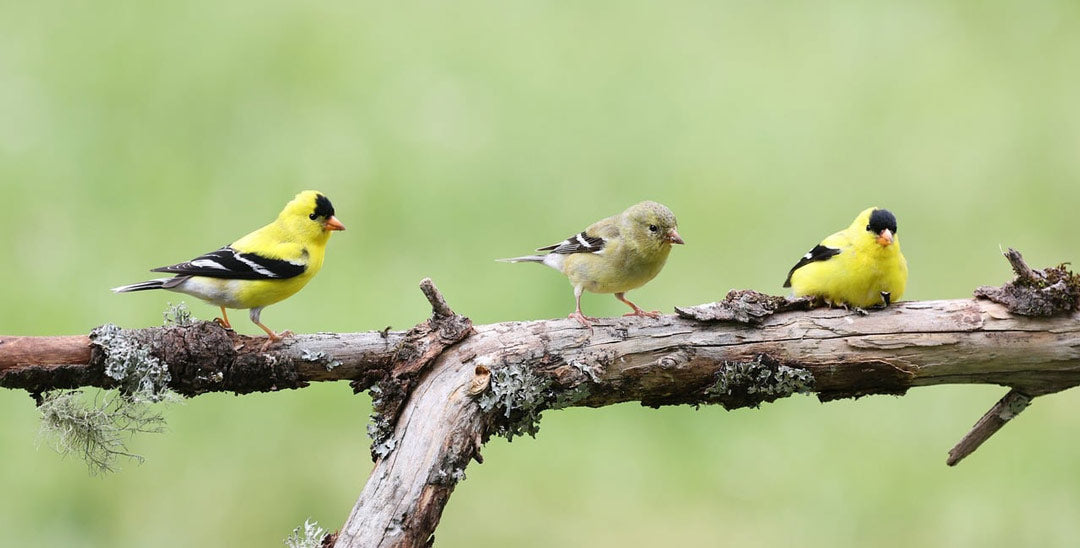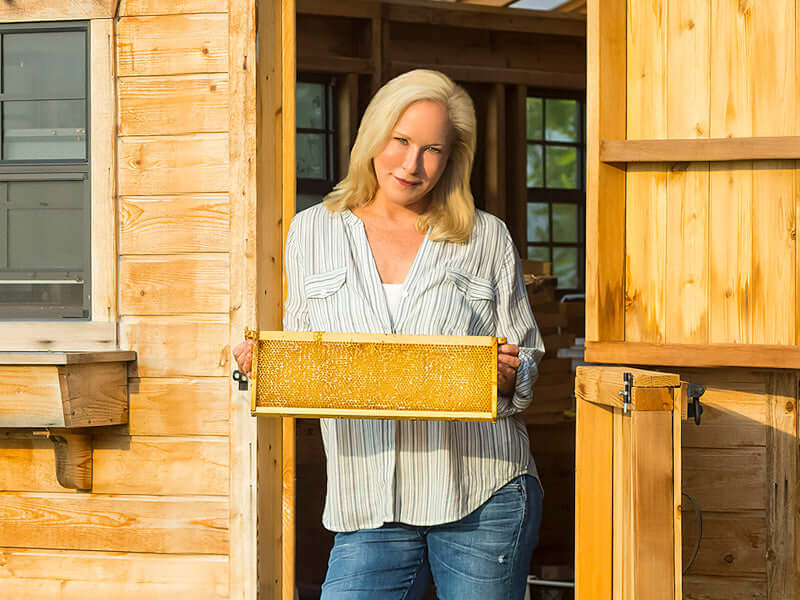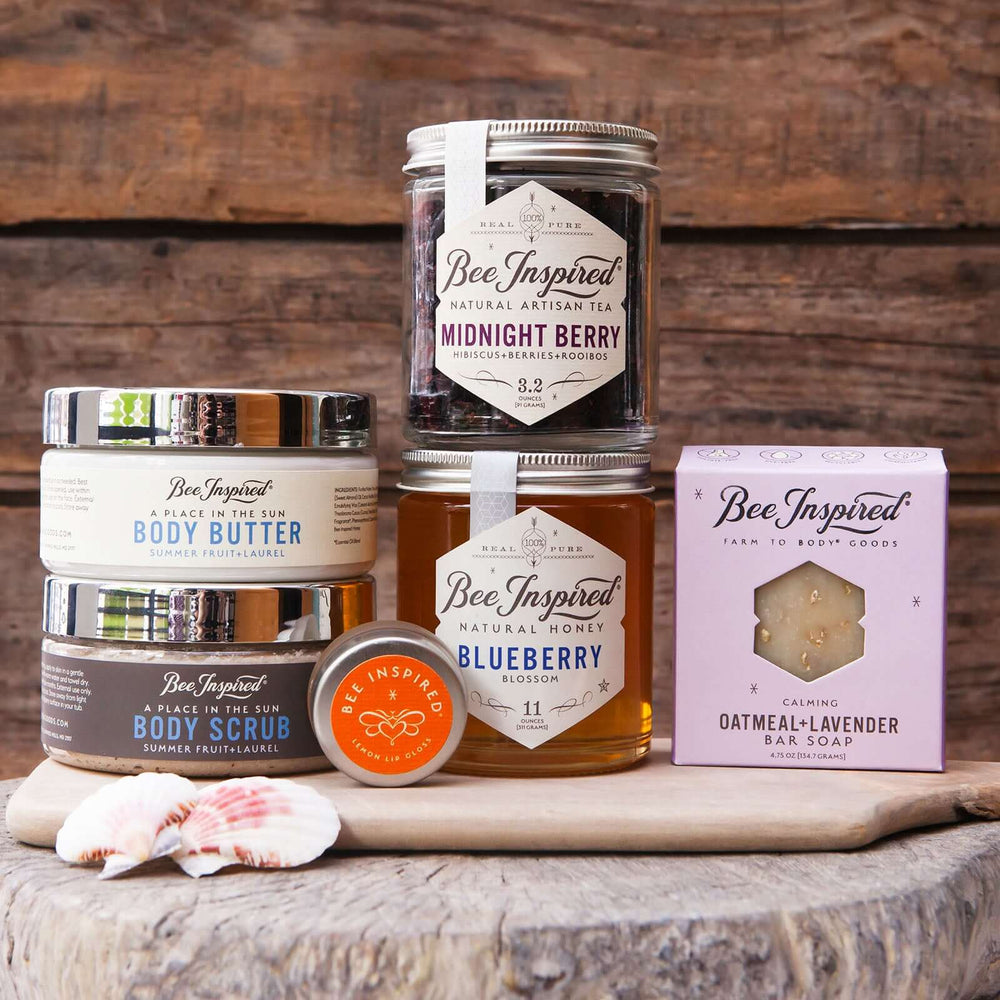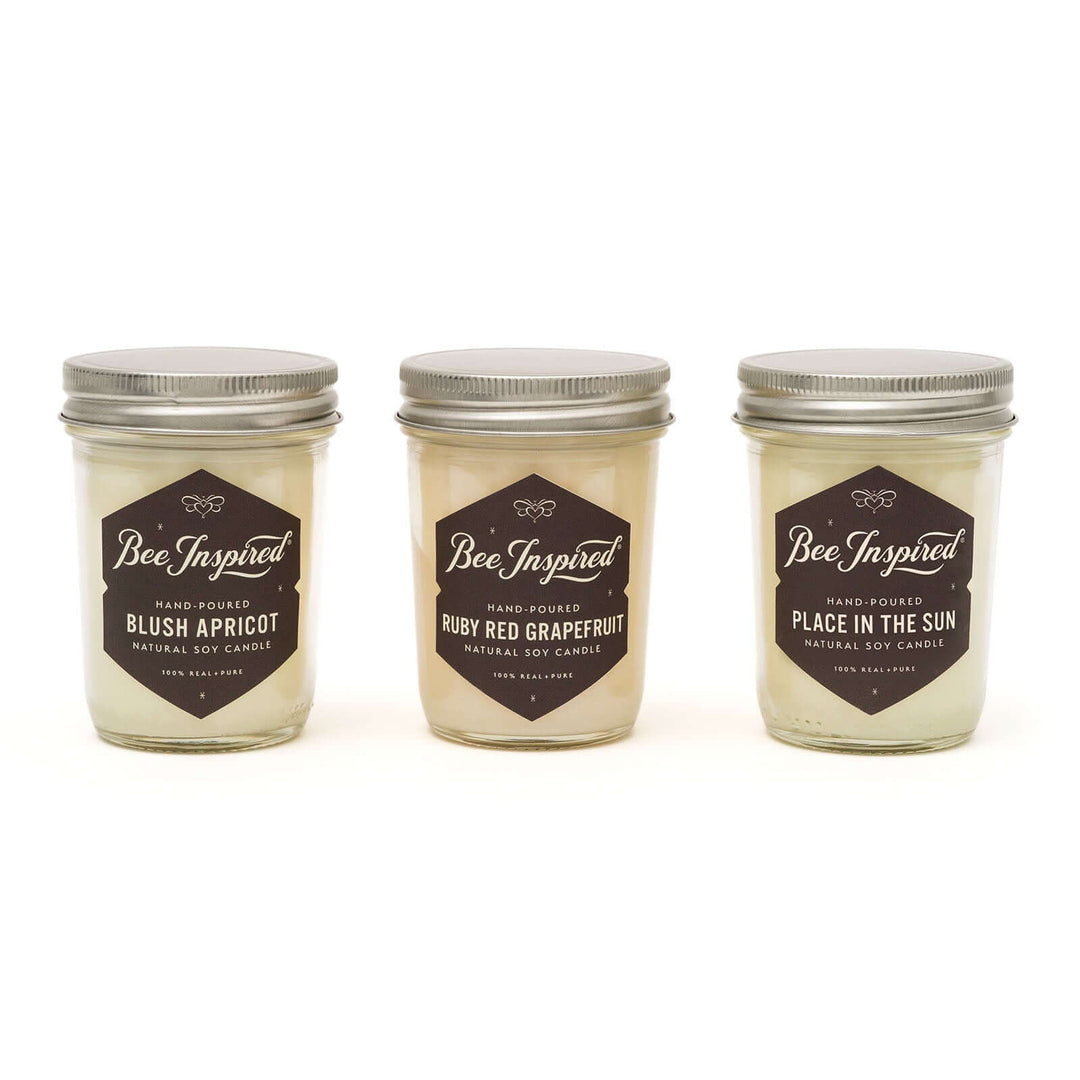Eastern Shore life is relaxing and beautiful, that is after we sit down for the day! Over the past few years, we have put in endless hours on our Kent Island farm to create the perfect environment for native plants and animals, including the Eastern American Goldfinch. Our bees produce two types of our Eastern Shore Honey, thanks to our efforts of planting sources of nectar. To share our paradise with you, we're publishing our Eastern Shore Life series to spotlight activities on the farm.

The American Goldfinch is one of North America's most beloved and recognizable songbirds. These vibrant yellow beauties bring joy to backyards, farms, and wild spaces across the continent. This comprehensive guide explores everything you need to know about these remarkable birds, from their stunning seasonal transformations to their fascinating behaviors and cultural significance.
Meet the American Goldfinch
The American Goldfinch (Spinus tristis), also known as the Willow Goldfinch or Eastern Goldfinch, is a small, vibrant songbird that captivates with its bright yellow plumage, cheerful songs, and energetic behavior. Often seen darting over meadows and open fields, these birds thrive in areas with weedy grounds and some tree cover. They are commonly spotted in floodplains, cultivated areas, roadsides, orchards, and backyards, making them a familiar sight across much of North America.
Physical Characteristics and Identification
Goldfinches are easily recognizable by their striking appearance, though their looks change dramatically with the seasons. Adult males during breeding season boast:
- Brilliant canary-yellow body feathers
- Jet-black wings adorned with white wing bars
- Black forehead and crown
- Notched tails
- Conical, seed-cracking bills
- White patches above and beneath their tail feathers
Size and Measurements:
- Length: 4.3-5.1 inches (11-13 cm)
- Wingspan: 7.5-8.7 inches (19-22 cm)
- Weight: 0.4-0.7 ounces (11-20 grams)
The Remarkable Seasonal Transformation
One of the most fascinating aspects of goldfinches is their complete molt twice per year—unusual among songbirds. This creates a dramatic seasonal transformation:
Spring/Summer (Breeding) Plumage:
- Males: Brilliant yellow with black wings, tail, and forehead
- Females: Duller yellow-olive with darker wings and no black cap
Fall/Winter (Non-breeding) Plumage:
- Both sexes: Olive-brown above, pale yellow below
- Males lose their distinctive black cap
- Wing bars become more prominent
This molting strategy helps them blend into winter landscapes while conserving energy during harsh weather.
Sexual Dimorphism and Age Variations
Sexual dimorphism in goldfinches is quite pronounced, particularly during the breeding season. While males exhibit bright yellow feathers and distinct black markings, females are more subdued with olive-brown upperparts and pale yellow underparts. This difference helps females remain camouflaged while nesting.
Juvenile goldfinches appear similar to winter adults but with:
- Cinnamon-buff wing bars
- More brownish coloration overall
- Less distinct markings

Can you spot the goldfinch in this photo?
Habitat and Distribution
American Goldfinches have one of the widest distributions of any North American finch, ranging from southern Canada to central Mexico. They favor open areas such as:
- Weedy fields and meadows
- Roadsides and woodland edges
- Floodplains and wetland margins
- Orchards and suburban gardens
- Agricultural areas with hedgerows
Breeding Season Territories
During breeding season, goldfinches establish territories in regions with high breeding densities, particularly:
- Great Lakes states
- North Dakota and southern Manitoba
- Northern New England
- Pacific Northwest
These regions provide the ideal mix of open fields and woodland edges that goldfinches prefer for nesting and raising their young.
Migration and Winter Distribution
Goldfinches demonstrate irregular migration patterns, often staying in northern regions during food-abundant winters and migrating south when conditions become harsh. They travel in compact flocks with an erratic, wavelike flight pattern.
Winter range includes:
- Southern Canada
- Throughout the United States (except southern Florida and Texas)
- Northern Mexico
On our Eastern Shore farm, goldfinches stay year-round but are most plentiful during summer and fall when food sources are abundant. We've installed 20-40 acres of native wildflowers and removed hundreds of non-native plants, creating an ideal habitat with bee balm, daisies, and naturally growing thistle.

Behavior and Social Structure
Goldfinches are highly social creatures with complex behavioral patterns that vary by season and situation.
Flocking Behavior
Outside the breeding season, goldfinches form large, nomadic flocks that can number in the hundreds. These flocks constantly move in search of food sources, following the ripening of seeds across the landscape.
Flight patterns:
- Distinctive undulating flight with alternating wingbeats and closed-wing glides
- Often call "po-ta-to-chip" during flight to maintain flock cohesion
- Can change direction quickly as a group
Territorial and Aggressive Behaviors
During breeding season, males become territorial and may show aggression through:
- Head-up displays with extended neck and legs
- Chasing other males from feeding and nesting areas
- Singing from prominent perches to establish territory
However, goldfinches are generally peaceful birds, and aggression typically subsides once eggs are laid.
Daily Activity Patterns
Goldfinches are most active during:
- Early morning (first 2-3 hours after sunrise)
- Late afternoon (2-3 hours before sunset)
- Midday rest periods in dense vegetation

Diet and Feeding Habits
American Goldfinches are primarily granivorous (seed-eating), with one of the most specialized diets among North American songbirds. Their diet consists of:
Primary foods:
- Seeds from composite plants (sunflowers, asters, thistle)
- Grass seeds
- Tree seeds (birch, alder, cedar)
Secondary foods:
- Tree buds (especially maple and elm)
- Maple sap
- Berries and small fruits
Seasonal protein sources:
- Insects (mainly aphids and caterpillars) during breeding season
- Provided primarily to nestlings
Foraging Techniques
Goldfinches employ various acrobatic feeding techniques:
- Hanging upside down from seed heads
- Perching on swaying stems
- Extracting seeds from partially opened pods
- "Goldfinch grip"—using feet to hold stems while feeding
Their specialized bills are perfectly adapted for extracting small seeds from tough seed heads, particularly thistle and sunflower seeds.

Nesting and Reproduction
American Goldfinches have one of the latest breeding seasons among North American songbirds, typically beginning in late June or July. This timing coincides with the peak availability of seeds and nesting materials.
Nest Construction and Site Selection
Nest characteristics:
- Location: Deciduous shrubs or trees, typically 4-14 feet above ground
- Placement: Horizontal or vertical forks in branches
- Construction: Tightly woven cup made of plant fibers, grass, and spider silk
- Lining: Soft materials like thistle down and cattail fluff
The female constructs the nest alone over 4-6 days, creating a remarkably sturdy structure that can support the weight of the entire family.
Reproductive Process
Breeding timeline:
- Eggs: 4-6 pale blue or bluish-white eggs
- Incubation: 12-14 days (female only)
- Nestling period: 11-17 days
- Fledgling dependency: 2-3 weeks after leaving nest
Breeding success factors:
- Late breeding season ensures abundant food for young
- Thistle down availability for nest construction
- Reduced predation due to dense vegetation
- Multiple broods possible in favorable conditions
Parental Care
During incubation:
- Male feeds female on nest
- Female rarely leaves nest except briefly to feed
After hatching:
- Both parents feed young regurgitated seeds
- Young are fed almost exclusively seeds (unusual among songbirds)
- Parents continue feeding fledglings for 2-3 weeks

Vocalizations and Communication
American Goldfinches have a rich vocal repertoire that serves various social and reproductive functions.
Song Structure and Learning
Male goldfinches produce complex songs consisting of:
- Variable series of twitters, warbles, and trills
- Songs lasting 3-20 seconds
- Learned components that vary by region
- Continued learning throughout their lives
Common Calls and Their Meanings
Contact calls:
- "Po-ta-to-chip" - flight call maintaining flock cohesion
- "Bay-bee" - soft contact call between mates
- "Swee-ee" - alarm call
Breeding calls:
- "Tee-yee" - male courtship call
- "Tee-di-di-di" - aggressive call during territorial disputes
- Canary-like warbling during courtship flights
Seasonal Variation in Vocalizations
Spring/Summer:
- Increased singing activity
- Complex territorial songs
- Courtship calls and displays
Fall/Winter:
- Primarily contact calls
- Reduced singing
- Flock coordination calls

Life Cycle and Longevity
Understanding the goldfinch life cycle helps appreciate their remarkable adaptability:
Juvenile Development
Nestling stage (0-17 days):
- Hatched naked and helpless
- Rapid growth on high-energy seed diet
- Develop flight feathers by day 11-12
Fledgling stage (17-35 days):
- Leave nest but depend on parents
- Learn foraging techniques
- Develop independence gradually
Juvenile stage (35 days-1 year):
- First molt into adult-like plumage
- Join winter flocks
- Prepare for first breeding season
Lifespan and Survival
In the wild:
- Average lifespan: 3-6 years
- Maximum recorded: 11 years
- High first-year mortality (60-70%)
Survival factors:
- Predation (cats, hawks, snakes)
- Weather extremes
- Food availability
- Disease and parasites

Interaction with Humans
Goldfinches have adapted remarkably well to human-altered landscapes, often benefiting from agricultural practices and suburban development that create ideal weedy habitat.
Attracting Goldfinches to Your Yard
Feeder recommendations:
- Nyjer (thistle) seed feeders
- Sunflower seed feeders
- Finch-specific tube feeders with small perches
- Multiple feeding stations to reduce competition
Native plant suggestions:
- Purple Coneflower (Echinacea purpurea)
- Black-eyed Susan (Rudbeckia)
- Sunflowers (Helianthus)
- Thistle species (Cirsium)
- Asters (Symphyotrichum)
- Zinnias (Zinnia elegans)
Water features:
- Shallow bird baths (1-2 inches deep)
- Dripping or moving water
- Clean water changed regularly
Seasonal Yard Management
Spring preparation:
- Clean and refill feeders
- Plant native annuals
- Provide nesting materials (cotton, small twigs)
Summer maintenance:
- Allow flowers to go to seed
- Maintain fresh water sources
- Monitor for nest activity
Fall/Winter care:
- Keep feeders consistently stocked
- Leave seed heads on plants
- Provide windbreaks near feeders

Conservation Status and Threats
The American Goldfinch is currently classified as "Least Concern" on the IUCN Red List, with stable and even increasing populations in many regions. However, they face several conservation challenges:
Current Population Trends
Positive factors:
- Adaptability to human-altered landscapes
- Protection under Migratory Bird Treaty Act
- Increased backyard bird feeding
- Agricultural practices creating weedy habitat
Population estimates:
- North American population: 42-47 million birds
- Generally stable or increasing trends
- Regional variations in population health
Threats and Challenges
Climate change impacts:
- Shifting precipitation patterns affecting seed production
- Temperature changes altering migration timing
- Habitat loss in wintering grounds
Human-related threats:
- Pesticide use reducing insect availability
- Window strikes during migration
- Outdoor cats (significant predation pressure)
- Habitat fragmentation
Disease and parasites:
- Salmonella outbreaks at feeders
- Avian pox
- Parasitic infections
Conservation Efforts
Habitat management:
- Preserve and restore native grasslands
- Maintain weedy field margins
- Reduce pesticide use
- Create pollinator-friendly landscapes
Citizen science participation:
- Project FeederWatch
- Christmas Bird Count
- eBird observations
- Nest monitoring programs

Cultural Significance and Symbolism
Goldfinches hold special meaning across many cultures and have inspired humans for centuries.
Historical and Cultural Symbolism
European traditions:
- Renaissance paintings featuring goldfinches
- Symbols of the soul and resurrection
- Associated with Christ's passion (crown of thorns reference)
- Representations of fertility and abundance
Native American cultures:
- Harbingers of luck and prosperity
- Feathers used in ceremonial dress
- Symbols of joy and positive energy
- Weather predictors in some traditions
Modern Cultural Impact
State bird designation:
- Official state bird of Iowa, New Jersey, and Washington
- Featured on state quarters and official documents
- Symbol of natural heritage and conservation
Art and literature:
- Inspiration for poets and artists
- Children's book characters
- Nature photography subjects
- Birdwatching enthusiasm
Spiritual and Personal Significance
Many people find personal meaning in goldfinch encounters:
- Symbols of happiness and optimism
- Reminders to embrace change and transformation
- Connections to nature and seasonal cycles
- Inspiration for resilience and adaptability

Fascinating Facts and Trivia
Unique Characteristics
- Late breeders: Among the latest nesting songbirds in North America
- Strict vegetarians: Adults rarely eat insects, even during breeding season
- Acrobatic feeders: Can feed upside down with remarkable agility
- Molt masters: One of few songbirds to molt twice annually
- Flock followers: Can travel hundreds of miles following food sources
Record Holders
- Longest-lived: Banded wild goldfinch lived 11 years, 3 months
- Clutch size: Typical 4-6 eggs, but up to 8 recorded
- Nest height: Usually 4-14 feet, but nests found up to 30 feet high
- Migration distance: Can travel over 1,000 miles seasonally
Interesting Behaviors
- Courtship feeding: Males feed females as part of pair bonding
- Roller coaster flight: Distinctive undulating flight pattern
- Nest recycling: May reuse nest materials from previous years
- Communal roosting: Winter flocks may roost together for warmth
Tips for Goldfinch Observation and Photography
Best Viewing Times
Optimal seasons:
- Late summer through fall (peak feeding activity)
- Early morning and late afternoon
- During seed head ripening period
Weather considerations:
- Calm, clear days for best observation
- After storms when birds are actively feeding
- Avoid extremely windy conditions
Photography Tips
Equipment recommendations:
- Telephoto lens (200-400mm minimum)
- Fast shutter speed for flight shots
- Tripod for feeder photography
Composition suggestions:
- Include natural habitat elements
- Capture seasonal plumage changes
- Focus on feeding behaviors
- Show flock dynamics
Behavioral Observations
What to watch for:
- Seasonal plumage changes
- Feeding techniques and preferences
- Flock formation and movement
- Territorial behaviors during breeding season
- Parent-young interactions

Celebrating the American Goldfinch
The American Goldfinch represents one of nature's most successful adaptations to changing landscapes. These remarkable birds have not only survived but thrived alongside human development, bringing joy and beauty to millions of people across North America. Their ability to transform dramatically with the seasons, their specialized feeding behaviors, and their complex social structures make them endlessly fascinating subjects for observation and study.
On our Eastern Shore farm, we've witnessed firsthand how creating the right habitat can support thriving goldfinch populations. By planting native wildflowers, maintaining weedy areas, and providing consistent food and water sources, we've created a haven where these beautiful birds can flourish year-round.
Whether you're a seasoned birder or someone just beginning to appreciate backyard wildlife, American Goldfinches offer countless opportunities for discovery and enjoyment. Their presence reminds us of the incredible diversity of life that surrounds us and the importance of preserving and protecting the natural world for future generations.
As we continue to face environmental challenges, the goldfinch's adaptability and resilience serve as both inspiration and reminder of our responsibility to maintain the habitats and ecosystems that support such remarkable creatures. By understanding and appreciating these birds, we take an important step toward becoming better stewards of the natural world.
The next time you see a flash of yellow in your garden or hear the cheerful "po-ta-to-chip" call overhead, take a moment to appreciate the complex and fascinating life of the American Goldfinch—a true jewel of North American birdlife.
Frequently Asked Questions
Q: How can I attract goldfinches to my backyard?
A: Use feeders with Nyjer or sunflower seeds, plant native seed-producing flowers like Purple Coneflower and Black-eyed Susan, provide shallow water sources, and maintain some "weedy" areas where seeds can develop naturally.
Q: What do goldfinches eat throughout the year?
A: Goldfinches primarily eat seeds from composite plants, grasses, and trees. They also consume tree buds, maple sap, and berries. During breeding season, they occasionally eat insects to provide protein for their young.
Q: Where do goldfinches live during winter?
A: Goldfinches migrate to warmer regions including southern Canada, the southern United States, and northern Mexico, where they can find abundant seeds in open fields and floodplains.
Q: Why do goldfinches change color?
A: Goldfinches molt twice per year, which is unusual among songbirds. This allows them to have bright breeding plumage in spring and summer and more subdued, energy-conserving plumage in fall and winter.
Q: When do goldfinches breed?
A: Goldfinches are among the latest breeding songbirds, typically nesting from late June through August. This timing coincides with the peak availability of seeds and thistle down for nest construction.
Q: What is the significance of goldfinches in different cultures?
A: Goldfinches symbolize happiness, prosperity, and spiritual ascension in many cultures. They represent joy and resurrection in European traditions and are considered bringers of luck and positive energy in Native American cultures.
Q: How do goldfinches communicate?
A: Goldfinches have a rich vocal repertoire including complex songs, contact calls like the distinctive "po-ta-to-chip" flight call, and various calls for courtship, territorial defense, and alarm situations.
Q: Are goldfinches good for gardens?
A: Yes! Goldfinches help control weed seeds and can assist with pollination. They're also excellent indicators of healthy ecosystem balance and bring beauty and activity to garden spaces.
Q: How long do goldfinches live?
A: In the wild, goldfinches typically live 3-6 years, though the maximum recorded lifespan is 11 years. First-year mortality is high, but survival rates improve significantly after the first year.
Q: What plants do goldfinches prefer?
A: Goldfinches favor seed-producing plants like sunflowers, thistle, asters, coneflowers, zinnias, and various native grasses. They particularly love plants in the composite family that produce small, oil-rich seeds.












